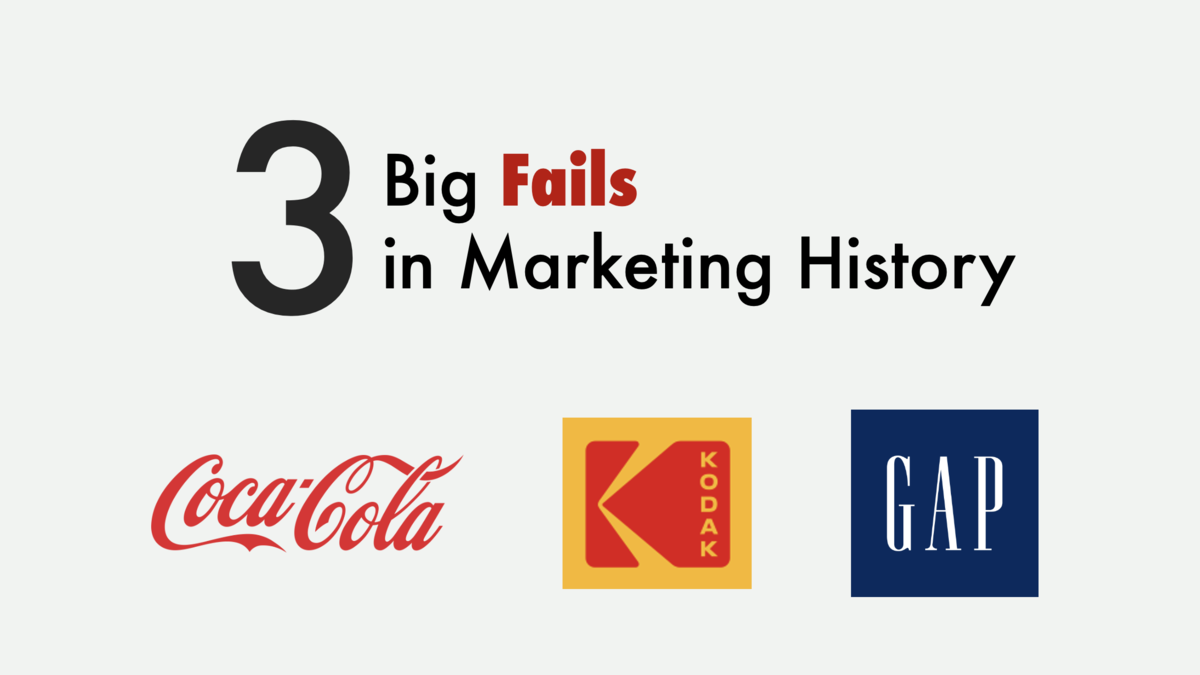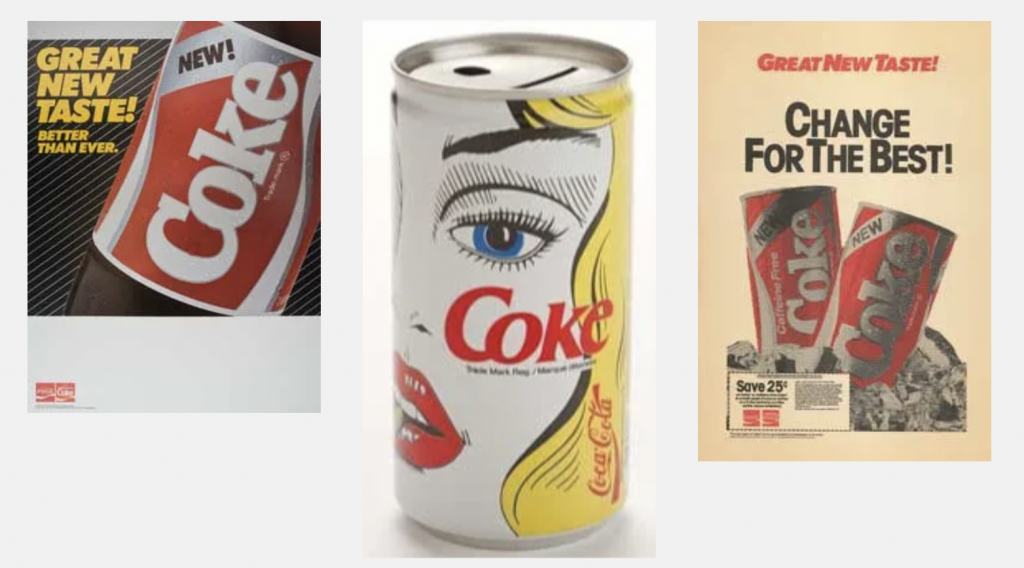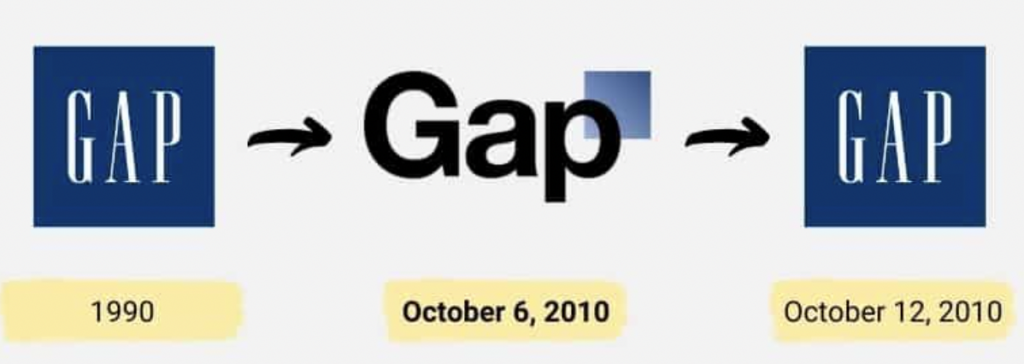blog»Business Strategy»Learning from Giants: The Mistakes of Coca-Cola, Kodak, and Gap and Their E-commerce Lessons

Learning from Giants: The Mistakes of Coca-Cola, Kodak, and Gap and Their E-commerce Lessons
2024/01/09
You can read this article in about 15 minutes
Introduction
Welcome to a journey through some of the most memorable chapters in marketing history, where even the giants like Coca-Cola, Kodak, and Gap had their fair share of stumbles. It’s fascinating how much we can learn from these moments, especially in the fast-paced world of e-commerce.
In this article, we’re diving into these companies’ well-known marketing mishaps not to point fingers but to unearth the golden nuggets of wisdom they left behind. Think of it as a casual chat about some pretty big blunders, but with a focus on what these can teach us today. From Coca-Cola’s adventurous yet ill-fated New Coke saga to Kodak’s digital photography reluctance and Gap’s logo redesign fiasco, there’s a wealth of knowledge to be gained. So, let’s get started and see what these stories can teach us about making smarter marketing moves in the e-commerce space.
Mistake 1: Coca-Cola’s New Coke – Misunderstanding Consumer Attachment
Who could forget Coca-Cola’s New Coke saga of 1985? In a bold move to stay ahead in the cola wars, Coca-Cola decided to change its century-old secret formula. It was a gamble, a big one. The idea? Modernize the taste to appeal to a younger generation. The reality? A classic case of “if it ain’t broke, don’t fix it.“

Here’s where it gets interesting for e-commerce marketers. Coca-Cola, thinking it was making a forward-thinking move, overlooked a crucial factor: consumer attachment. People didn’t just like the original Coke; they loved it. It was part of their lives. When New Coke hit the shelves, the backlash was immediate and loud. Customers felt like a part of their history was being taken away, and they weren’t shy about letting the company know.
The lesson here is clear: never underestimate the power of emotional attachment your customers have to your product. In the e-commerce world, this could be anything from a product’s traditional design to a familiar user interface on your website. Before making any major changes, it’s crucial to gauge customer sentiment. Conduct surveys, run focus groups, or even beta test the change with a small segment.
In the end, Coca-Cola had to bring back the original formula, rebranded as “Coca-Cola Classic,” to pacify their customers. This incident became a textbook example of why understanding and respecting your consumer base is key. So, when you’re thinking about revamping your e-commerce platform or launching a new product, remember the New Coke story. It’s a reminder that sometimes, tradition and customer loyalty are worth more than a new twist.
Mistake 2: Kodak’s Missed Digital Revolution – Failure to Adapt
Kodak, a name once synonymous with photography, offers a classic example of a giant caught off-guard by technological change. This tale begins with Kodak at the top of the film industry, virtually unchallenged. Interestingly, Kodak wasn’t just playing in the field; they were actually leading some early innovations in digital photography. Yes, you read that right. The digital tech that eventually disrupted their business was something they had a hand in pioneering!

Here’s where the plot thickens. Despite having the tech in hand, Kodak hesitated to go all-in on digital photography. Why? They feared it would cannibalize their highly lucrative film business. It was a classic case of being trapped by their own success, unable to see beyond their existing business model. The world was sprinting towards digital, and Kodak chose to stroll, believing that their traditional film business was untouchable.
For e-commerce marketers, Kodak’s story is a vivid reminder of the need to adapt. In a digital age, clinging to what works today without planning for tomorrow can be a risky game. Kodak’s reluctance to embrace digital, fearing it would hurt their film sales, was a short-sighted decision. In e-commerce, this is akin to avoiding new online marketing strategies or emerging platforms for fear of disrupting current sales channels.
The key takeaway? Stay alert and be willing to pivot. Whether it’s adopting new technologies, exploring emerging market trends, or just trying out a new social media platform, staying ahead of the curve is crucial. E-commerce is an ever-evolving landscape, and adaptability isn’t just a nice-to-have; it’s a must-have. You don’t want to be the next ‘Kodak moment’ of missed opportunities, do you?
Kodak’s story is a powerful lesson in foresight and the courage to embrace change, even when it feels uncomfortable. It’s about recognizing that the winds of change are not a threat, but an opportunity to set sail towards new horizons.
Picture this: Gap, a well-loved and recognizable brand, decides one day in 2010 to revamp its iconic logo. It sounds like a fresh start, right? Well, not quite. What ensued was a classic case of “good intentions, bad execution” that left marketing textbooks with a new cautionary tale.
Mistake 3: Gap’s Logo Redesign Disaster – Underestimating Brand Identity
For over two decades, Gap’s logo – that classic blue square with the white lettering – had been a symbol of casual, American style. It was familiar, comforting, and most importantly, deeply embedded in the customer’s psyche. Then came the new logo: a small blue square perched atop plain black text. To say it was received poorly would be an understatement. Customers and design lovers alike took to social media to express their dismay. The backlash was swift and brutal.

But why did this happen? Gap’s mistake wasn’t just a poorly designed logo. The real issue was underestimating the emotional connection people had with the original. This move felt to many like a betrayal, a corporation turning its back on its own identity – and by extension, on its loyal customers. It was a harsh reminder that in retail, and by extension in e-commerce, your brand identity is not just a logo; it’s a part of your customer’s identity.
For e-commerce marketers, Gap’s blunder is a lesson in brand consistency and customer perception. Before making any radical changes, it’s crucial to ask: How will this be received by our loyal customers? Are we enhancing our brand or alienating it from its core base? It’s essential to understand that changes in branding, especially for well-established names, need to be handled with sensitivity and ideally, with customer input.
The Gap incident also underscores the power of social media as a double-edged sword. While it offers a platform for brand promotion, it also acts as a public forum for customer feedback – immediate and uncensored. In today’s digital world, customer reactions are amplified and spread at lightning speed. E-commerce businesses must be prepared to respond quickly and effectively to this feedback.
After a week of intense criticism, Gap reverted to its original logo, admitting that they had missed the mark. This episode, though a setback, offers a rich learning opportunity. It shows the importance of testing new ideas with a focus group or a segment of your target market. Had Gap taken this approach, they might have gauged the public’s attachment to the old logo and avoided the whole fiasco.
In essence, Gap’s story teaches e-commerce marketers about the value of brand heritage, the importance of customer loyalty, and the need to tread carefully when it comes to rebranding. It’s a reminder that in the digital age, listening to and understanding your audience is more crucial than ever. So, before you jump onto the bandwagon of rebranding or radical changes, remember the Gap logo debacle. Sometimes, the best move might just be to stick with what works and what’s loved.
Conclusion
As we wrap up our exploration into the marketing misadventures of Coca-Cola, Kodak, and Gap, it’s clear that there’s much to be learned from these giants of the industry. Each story’s unique set of circumstances and outcomes serves as a rich repository of insights for today’s e-commerce marketers.
From Coca-Cola’s New Coke fiasco, the key takeaway is the value of customer loyalty and the dangers of underestimating emotional attachments to a brand. It’s a vivid reminder that in the digital age, where consumer feedback is immediate and loud, understanding and respecting your audience’s preferences is paramount.
Kodak’s hesitation in embracing digital photography teaches us the critical importance of adaptability and foresight in a rapidly evolving market. For e-commerce, this translates into staying abreast of technological advancements and consumer trends and being bold enough to pivot when needed.
And then there’s Gap’s logo redesign debacle, a cautionary tale about brand identity and the power of customer perception. It underscores the need for e-commerce brands to approach rebranding with caution and extensive customer input, respecting the legacy and emotional connection that customers have with a brand.
In conclusion, these stories collectively emphasize the importance of being customer-centric, adaptable, and sensitive to market dynamics in the e-commerce world. As we navigate through our own marketing journeys, let’s keep these lessons in mind. By doing so, we not only avoid repeating past mistakes but also chart a course toward more informed and successful marketing strategies.